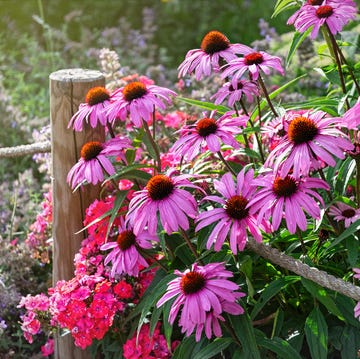Poison ivy might be a small plant, but it can cause big trouble—for both your yard and your skin. Its oily sap, called urushiol, is what triggers that itchy rash, and even a tiny amount can cause a reaction. It often shows up where you least want it—creeping along a garden fence, climbing a tree, or popping up in your flower beds—and like crabgrass in your garden, it has a frustrating way of coming back even after you think you’ve gotten rid of it.
That’s because, as Amy McCord, florist and founder and CEO at Flower Moxie, explains, “Like bamboo, poison ivy has an extensive root system of underground rhizomes that sprout new growth over far distances. Dormant buds can also sprout months later, which is why digging out the roots tends to be most effective combined with targeted herbicide.” The good news is that with the right strategy, you can learn how to kill poison ivy and reclaim your outdoor space for good. Ahead, learn the most effective ways to get rid of it and a few expert-approved solutions to keep it from coming back.
How to identify poison ivy:
To identify poison ivy, look for three pointed leaves growing from a single stem. “Leaves of three, let it be” is the classic reminder. Poison ivy typically grows as a climbing vine along trees and fences or as a low shrub. In spring and summer, the leaves are usually green and sometimes shiny from the rash-causing urushiol. In late summer, you might also see small white or greenish berries. In fall, they can turn red, orange, or yellow.
What kills poison ivy the fastest?
If you want quick results, chemical herbicides are your best bet. “While natural methods do exist, commercial herbicide will be the most effective treatment for poison ivy,” says McCord. “It can be directly sprayed onto the leaves, and the leaves will begin to yellow and curl within a few days.” Choose a product labeled for poison ivy that contains glyphosate or triclopyr, and spray on a dry, calm day to avoid harming nearby plants.
What is the best homemade poison ivy killer?
For a DIY approach, you can make a simple spray with items you may already have at home. “Vinegar, salt, and dish soap mix is the most common DIY option: 1 gallon white vinegar, 1 cup salt, 1 tablespoon dish soap,” says McCord. Spray it directly on the leaves, but be careful—this mixture can harm other plants and temporarily change the soil’s pH.
What kills poison ivy permanently naturally?
If you want to avoid chemicals altogether, physical removal is the best method. “While wearing complete protective gear, digging out the roots will remove the poison ivy permanently,” says McCord. Another natural method is to smother the plant by covering it with plastic for several weeks during hot weather. This cuts off sunlight and heat-bakes the plant until the roots die.
When is the best time to kill poison ivy?
Timing makes a big difference. “Late summer to early fall is the most effective time, as that is when a plant pulls nutrients down into the roots to prepare for winter,” says McCord. “The herbicide will go deeper into the plant.” Even if you’re using natural methods, tackling poison ivy at this time of year helps ensure you'll get rid of this pesky plant—for good.

Tierney McAfee is a freelance writer and Country Living and The Pioneer Woman contributor who covers entertainment, holiday & entertaining, food & drinks, design ideas, DIY, and more.













